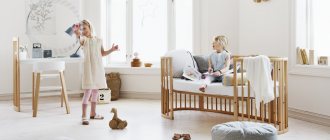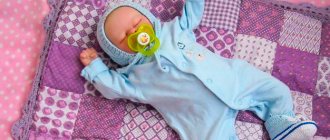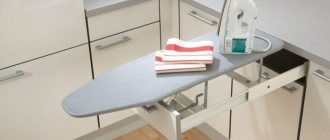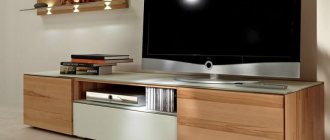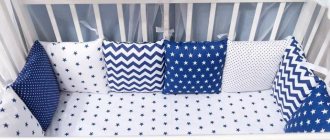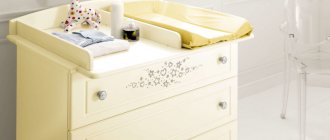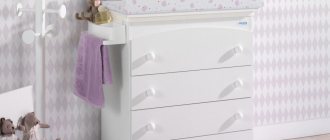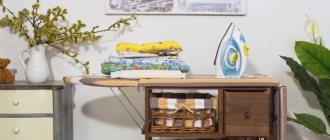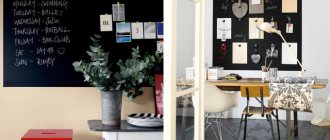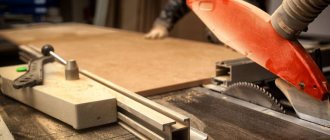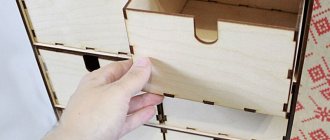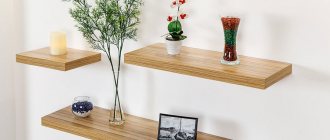When a baby is born into a family, the mother tries to provide him with the most comfortable conditions and protection. One of the useful devices for caring for newborns is a changing board. This product has low soft sides, due to which it prevents the child from rolling in different directions. However, when purchasing such a product, a number of questions may arise, because each type of such device has its own nuances. We will consider in detail below what you need to know in order to make the right choice.
Peculiarities
As a means of facilitating daily baby care, the changing board does not replace a special table or other type of stationary furniture. However, it is distinguished by a prepared type of surface, which makes swaddling a baby on it much more convenient and faster than doing it on a regular table or bed. The distinctive features of this device from its stationary type analogues are the following:
- mobility;
- light weight;
- compact dimensions;
- acceptable cost.
Unlike changing tables, such products do not restrict space even in small apartments or private houses. Some varieties are mobile to such an extent that, if necessary, such pads can be taken with you on a trip or even on a visit. Such devices are safe for the baby. They prevent it from falling from the height at which the changing board is currently located, even with awkward manipulations. As a rule, the surface of the product is made of non-slip material in order to prevent the child from slipping.
Depending on the variety, it can be installed on a bed, table, crib, or even a chest of drawers. It does not replace a changing table, since it does not have drawers or roll-out drawers, compartments for linen or baby care products. This is nothing more than a plane on which you can swaddle, clean the baby's skin, and in some cases, put the newborn to sleep. In some cases, mothers are especially careful when choosing changing boards. They are initially going to use them as massage and exercise tables for babies.
The best changing chests within 15,000-25,000 rubles
Changing chest Feretti Voila Bagnetto
Rating: 4.9
The first place is at the chest of drawers, which will fit perfectly into any interior, will not take up much space, and will delight parents with its practicality and safety for children. It can be installed in any zone and changed position at your discretion several times a day. Convenient wheels will not scratch the floor covering. They are fixed. The absence of small fittings and sharp corners ensures that the baby will not get injured during swaddling, and when he grows up, he will avoid abrasions and bruises.
The top cover with the changing mat folds down. Inside there is a bathtub with a soap compartment. The water is drained using a hose. You can perform any action on the table: massage, change a diaper, dress your baby for a walk. The necessary care products will always be at hand, which can be placed on a spacious shelf on the side of the case.
The chest of drawers is equipped with three drawers with a silent TIP-ON opening system. Parents who have already tried the model in practice were satisfied and recommend the Italian changing chest for purchase. As the child gets older, unnecessary accessories are simply removed and can be used for a long time.
Advantages
- reliable, safe components;
- easy silent opening/closing;
- removable wheels with stopper;
- long service life;
- stylish laconic design.
Changing chest Erbesi Bubu/Fiocco
Rating: 4.8
Next in our review we present a chest of drawers that will create coziness in a newborn’s room and will become indispensable furniture in the house. It was produced at one of the famous Italian factories, which specializes in children's products. This elegant model in white is created from environmentally friendly solid beech wood. Comfortable ergonomic handles in the shape of cute bears are decorated with bows.
A minimum of small details guarantees absolute safety for infants and older children. The changing board reclines. The bathtub has indentations corresponding to the anatomical structure of the child’s body. The drawers open quietly and smoothly and close the same way. They are quite roomy. The model can be moved using silently rotating wheels, which are equipped with a stopper.
The manufacturer has also provided for the continued use of the model as the child grows older. The changing table and bathtub are removed and it transforms into a stylish chest of drawers. All reviews about Bubu/Fiocco are positive. Thanks to its thoughtful design, it will not tip over and injure the baby playing nearby. There is also no risk of injury during swaddling.
Advantages
- expensive materials;
- elegant design;
- the presence of a comfortable bath;
- movement without damage to floors;
- long time of use.
Red Star S 421 Mozhga
Rating: 4.7
In third place is the Russian model with a very stylish design and maximum functionality. It is made of solid birch and high-quality MDF. A wide selection of shades from white to dark wood allows you to choose a chest of drawers that best suits your existing decor. It has an optimal height corresponding to the average height of an adult. This creates additional convenience when changing the child’s clothes and during the massage procedure.
An undoubted advantage is the increased changing surface. The chest of drawers is equipped with four drawers with quiet, smooth movement. The model has open shelves for storing care products and other accessories. The changing board can be removed without damaging the appearance of the furniture. The chest of drawers can later be used both in a children's room and in an adult bedroom or living room.
Parents gave the chest of drawers top marks. The thoughtful design allows the wide changing table to be used for a long time. The presence of shelves and additional top flooring increases the storage space for hygiene items.
Advantages
- natural materials;
- strong silent guides;
- expanded changing area;
- various colors;
- stable, strong construction.
Varieties
The classic version of the changing board is a product with an optimally rigid base, a flat central part and small fences. The sides are located at an angle relative to the working surface. This option is used at home because it does not involve carrying. The fences themselves may vary in shape. For example, they can be made in the form of soft rollers, protecting the working plane not only on two, but even on three sides, which helps protect the baby from falling when he is pushed away from the base with his legs.
In addition to the round shape, they can be triangular and even flat, differing in width at different corners of the structure, along the entire length of the edge or mostly at the head. In some models this is reflected in the internal space, but the safety of such boards is much greater.
Manufacturers produce these products in a wide range, which is reflected not only in the color palette and enclosing elements. Products vary in material, size and shape. In addition, they differ in the place of use. However, all varieties are designed for laying removable cloth diapers, which protects the baby from contact with the cool surface of the board.
Often the design can be supplemented with fixing elements, for example, legs that secure the board to a specific base. This feature allows you to add strength to a simple product and completely secure it for child care. In this case, the possibility of the board slipping during any movement of the mother or baby is eliminated.
In addition to these options, companies produce models that are closer to traditional changing tables. For example, these products may have supports of greater height compared to the conventional model range.
Other varieties include designs with wheeled legs or analogues with a removable top part, which can be used as an additional board for changing or hygiene procedures in child care.
Options for the bed are products of the classic type, with reliable supports and belts with locks.
Examples of finished tables
Today, furniture stores provide a wide range of ready-made changing tables, so we recommend that you do not spontaneously rush to make your own product, but first familiarize yourself on the Internet with all existing types and specific models presented on the websites.
You can make a more complex design for the changing table.
Thus, making a changing table with your own hands is not difficult, you just need to carefully understand the manufacturing features. This will save the family budget and allow you to take into account all the requirements for the product.
And most importantly, you will be confident in the quality and safety of furniture for your baby. In addition, a homemade piece of furniture will have special value for your family, creating comfort and a special atmosphere of love and warmth.
Materials
In the production of changing boards, brands use different raw materials. More often on sale you can find products made of plastic that are resistant to various mechanical loads. For substrates, the company uses latex foam, which can hold the desired shape for a long time and allow air to pass through. Latex is a hypoallergenic material, because it does not irritate children's skin.
As a top or sheathing layer, manufacturers use rubber derivative materials, which are not only resistant to water. Today it is a fairly durable raw material, which is characterized by resistance to mechanical stress and frequent cleaning. They can have a variety of colors and themes, so choosing a product to match the overall style of the nursery today will not be difficult.
How to choose?
Depending on the type of product and its size, it is purchased purposefully, based on the specific environment of the nursery. For example, if there is a children's chest of drawers without a top, they try to take an overlay for the chest of drawers. When there is very little space, take a changing board for the crib or a stand with fastening to the bed. At the same time, they try to take into account the dimensions of specific, existing furniture that is planned to be used for daily care. It is important to understand that these products are not changing tables, since, in addition to the table top, they do not have other elements inherent in such structures.
The choice of board and table has nothing in common. The board is taken separately, but adjusted to the specific measurements of the furniture. Even wall-mounted folding-type options are not, in fact, boards, because they have not only a board, but also a rack for placing the necessary accessories. When purchasing, you need to pay attention to the type of upholstery material. In addition, it is important that the covering is tight and that the product itself does not have sharp corners.
The working surface should not be soft, because the baby should not fall into it. The mat model is not the best solution, since this option will be inconvenient for changing. You need to take a product that has an optimally rigid base.
Despite a lot of conflicting opinions, we should not forget about the formation of the skeleton in the first year of a baby’s life. The product should not be soft, because this will increase the daily load on the baby’s spine. It is important to take care of the size, because children grow very quickly during the first months of life. For example, there is no need to take the 60x58 cm option when the furniture allows you to place a product with dimensions of 72x72 cm on the surface. Regarding the crib options, it is worth noting: they are the right solution if there are no other methods. This is far from the most convenient solution, especially in cases where the bed has the functions of a swinging cradle.
The best options are models with clamps that can be installed on a hard surface. For example, it could be a table or a chest of drawers. However, it is not enough to choose a base: you need to pay attention to the sides. Their height should be sufficient so that an active baby cannot fall over them.
Ideally, there should be enough space inside to accommodate a six-month-old baby at full height with good margin on the sides, top and bottom. In this regard, it is worth considering the fact that usually options with large sides have a small working surface inside.
Types of changing surfaces
Modern models of children's furniture differ in their functionality, cost, dimensions and purpose.
There are several main types of these structures. These include:
Folding changing table. This model is considered mobile and budget. The structure of the structure contains light types of materials.
The mattress is made of oilcloth fabric and soft filling. The size of the product is 80 cm x 100 cm. There are thick handles at the top.
Chest of drawers with changing table. This option is made from heavy-duty materials. There is a spacious storage system for children's things.
The tabletop is quite wide and roomy. It is made from natural wood. The surface is covered with acrylic paint.
The mattress is made of dense material and silicone filler. The height of the products is from 100 to 120 cm. The width is from 80 to 100 cm.
Wall-mounted changing table. It is a prefabricated structure. As needed, it easily folds out into a spacious place to serve the baby.
- Tables 2022 - 150 photos of exclusive new items from the furniture catalog. Modern design of tables, and the best options for combining them in the interior
- Wooden chairs - main types, types of wood and modern models (90 photos and videos)
- Adjustable chair - features of choosing a design and tips on choosing a material (145 photos)
Changing rack. It is a metal or plastic structure. At the top there is a wide changing board. There are small drawers at the bottom.
The main advantages of this model are lightness and mobility during operation. This table can be easily moved to any point in the interior space.
The photo of the changing table shows this model of furniture paraphernalia.
Built-in changing pad. This model is presented by the Swiss company Ikea. A board for changing clothes and swaddling is an addition to the baby's crib. Ikea changing tables are made of durable chipboard and fiberboard.
- Folding chair: main categories, features of creation and use in the interior (90 photos)
- Computer chair - modern models, features of choice and the best ideas for use (85 photos)
- Extendable table - features of application and methods of arrangement in the interior (80 photos)
The main advantage of this option is its availability. When the baby grows up, the top part of the table can be completely removed. As a result, an additional shelf appears for storing various small items.
Reviews
According to the comments of many mothers left on the Internet, changing boards are a fairly popular device that makes caring for a baby easier from birth to six months, or even more. Such products can replace a massage table, a surface for daily exercise and changing clothes, a mat for the first attempts at climbing and flips. All mothers consider the disadvantages to be the fact that changing boards, despite all their benefits, become small too quickly. In addition, they are not full-fledged furniture.
For a review of the Globex “Comfort” changing board, see the following video.
A changing board is a good solution for arranging a place for changing your baby's clothes and carrying out some hygiene procedures. Recently, more and more young mothers prefer a changing board instead of a changing chest. The board does not require separate space, is easy to carry and wash.
What do we need?
After creating the drawing, the resulting detailing should be given to a company that professionally cuts materials for furniture. After this, the necessary materials are purchased:
- laminated chipboard;
- MDF;
- accessories;
- wood fiber material that will be used to create the back wall of the chest of drawers.
The result is this set of blanks.
The master class was based on the instructions from the user of the yaplakal Antonim forum.
Stage No. 1. Attaching the edge
The product uses a paper edge that you can attach yourself. Before pasting, do not forget to cover the floor in your apartment or garage with fabric so that the trim does not spread around the entire perimeter. Refer to the following instructions during operation:
- Heat the iron, it is better to use older and heavier models.
- Apply glue to the back of the edge, attach it to the furniture, and then carefully go over the edge with an iron.
- Once the edge is secured, use a knife to trim off any excess edge around the edges.
- Now use a block covered with sandpaper to smooth the ends.
This is how sanding is done to prevent the paper applied to the furniture from peeling off.
The result is a smooth surface and elements ready for assembly.
After pasting, remove the trimmings, of which there is probably a lot left.
Stage No. 2. Let's start assembling the boxes
If you don’t want to mark out small parts for a long time and involve help, then for assembly, take a hand clamp from your friends, with which you can securely fasten the structural elements.
With a clamp, work progresses faster.
After this, use a drill to drill the holes, and then you should use furniture screws (confirmed).
As a result, we get such a box, and there are two more to be made.
In just 1.5 hours you can make 3 pretty cute drawers, which you can then use to complement your changing chest.
Stage No. 3. We mount guides and a rotating element
Now on the side walls of each drawer you need to apply markings for fastenings for the guides. For a changing table, it is better to choose full extension guides.
To mark, use a pencil, tape measure and a regular ruler.
We get the following construction. It is worth immediately attaching guides to all elements.
Now we attach the guides to the side walls of the table. This is much easier than installing guides in an already assembled product.
Let's start marking the rotating elements in which we will drill holes for the ties.
It is worth using the clamp again to ensure the accuracy of the markings and holes.
You can attach an unnecessary sheet of chipboard to the last element while drilling holes. This way the contours of the holes are very smooth and there will be no torn edges.
Changing board - what is it?
A newborn baby requires frequent changing of clothes and hygiene procedures. These manipulations can be conveniently performed on a chest of drawers or changing table. These tables have edges to prevent the baby from falling, and many drawers in which you can store things. The downside of changing tables is that they take up a lot of space. A good alternative to such tables and chests of drawers is a crib changer or changing board.
Changing pads, or changing boards, consist of a solid rectangular base, sides, a mattress and an oilcloth covering. They are easy to care for, wash, wipe. Changing pads come in different shapes and sizes, but they are all lightweight and compact. The changing board can be used in the bathroom, on an adult and child's bed, on a dresser and during travel and trips.
What is a changing board for?
Women preparing to become mothers are faced with the question of whether a changing board is needed. This item cannot be considered an essential item, so if you wish, you can do without it. It would be more correct to say that it is designed for comfortable care of a newborn. The changing board is used for changing the baby's clothes and carrying out hygiene procedures. These actions can be performed on a changing chest, table or bed, but in this case special diapers and oilcloth are required.
The oilcloth is fixed on the changing board, so it will not crumple when changing the baby. It is easy to wipe and wash. Many mothers who have used changing pads have been satisfied with them. They speak of them as things that have made caring for the baby much easier. The removable diaper diaper has such advantages as compactness, portability, ease of use, and safety for the baby.
Changing chest or board - which is better?
A special chest of drawers and a board are the most popular changing items. Each of them has its own advantages and disadvantages.
- The changing board is equipped with a protective edge, thanks to which the baby can be left alone for a while without fear of him falling on the floor. In addition, it is transportable.
- It can be easily moved to any corner of the house.
- Another advantage of this item is its reasonable price.
Among the disadvantages, experts highlight the lack of need for operation after the child grows up.
A changing chest has many advantages.
- One of them is the ability to store all the necessary accessories for changing at the place of manipulation. Thanks to this, parents can immediately change their baby’s clothes as soon as the need arises, rather than going to the closet in search of diapers and undershirts.
- The advantage of such a piece of furniture is also that it can be used after the child grows up. It will be enough just to remove the board. After this, the chest of drawers is used for its intended purpose.
The disadvantages include the fact that this piece of furniture requires a special place for it. The chest of drawers cannot be removed and then taken out when the need arises. This piece of furniture will always be in the room. The disadvantages also include the high price of the chest of drawers.
Having compared all the pros and cons, the consumer himself decides which item to use for swaddling the baby.
How to choose a changing board?
A large selection of changing boards is not always an advantage. Among the huge assortment, it can be difficult to decide which model is worth taking.
When choosing a changing pad, it is recommended to pay attention to the following points:
- Product material: wooden boards are more expensive, heavier, but stronger and more reliable.
- If you buy a changing board, the dimensions must correspond to the purpose and age of the baby. It is better to buy a large changing pad right away so that you can use it for several months.
- If you want the changing board to stand separately, you can buy a model with legs.
- To mount it to the crib, you should buy a table with special fasteners.
- The side of the changing pad should be high to ensure the safety of the baby.
- Changing tables can be equipped with a variety of accessories and toys that are not essential, but can make caring for your baby easier.
Changing board for crib
Before choosing a changing board for your chest of drawers or crib, you should familiarize yourself with the various models.
When choosing, it is important to pay attention to the following points:
- Fasteners or straps that will mount the table to the crib.
Often, a changing board for a crib with fastening is equipped with belts. It is necessary to check that the belts are strong and have reliable latches. - Sides.
Models with high sides are more reliable and safe. - Retainers for the baby.
When the mother turns away, tightly secured fasteners guarantee the baby’s safety, so you should choose models with wide and reliable belts. - Board material.
For use on a crib, it is better to choose wooden models. - Load.
For use on a crib, pelenators with a permissible load of 10-15 kilograms are more reliable.
Changing board on the chest of drawers
A changing board for a chest of drawers with a fastening allows you to fix the table in one position. This is convenient when the changing pad will not move around the room. If the changing board on the chest of drawers is used in different places, then it is not always convenient to attach it to the chest of drawers. Changing boards for chests of drawers are presented in a large assortment and variety. You can choose models with additional compartments for baby care products, play materials and additional accessories.
Bath changing board
A bath changing board helps you dry and dress your baby without leaving the bathroom. Such pelenators have special legs-stands or fastenings for fixing the board on the bathtub. For the bathroom, you should give preference to plastic diapers that are not afraid of moisture. It is convenient if there are compartments on the side of the changing board in which you can put the necessary accessories: creams, pacifiers, toys.
Construction and equipment of a chest of drawers with a changing table
When choosing a chest of drawers for changing, it is important to understand how it works, determine the size, material of the product, as well as the quality of the fittings and the design itself.
Frame
This design consists of four main elements:
- The upper horizontal surface, which is the changing table, or the base for its fastening.
- Lower horizon.
- Back wall.
- Two side walls.
The dimensions of the module can be quite different and you should choose a model taking into account the following parameters:
- The height should be such that it is convenient for the mother to perform the procedures.
- The width and length should be such that the baby not only fits on the table, but feels free on it, and do not forget that the width is also the capacity of the drawers.
If we talk about standard sizes, they are as follows:
- Height – from 90 to 110 centimeters.
- Width – from 50 centimeters.
- Length - from 60 to 90 centimeters.
The larger the chest of drawers and tabletop, the longer a child will be able to fit on it, and it will be possible to use it for its intended purpose.
Filling
The main storage system is drawers. Their number can be on average from 3 to 8. Large, roomy sections can be used to store clothes, diapers and nappies. Hygienic supplies are placed in smaller boxes: cotton pads, swabs, pipettes and medical solutions: peroxide, brilliant green, oils.
You can choose a model with shelves and open niches. It’s convenient to place baby cosmetics on the shelves, and put pacifiers, rattles, sanitary napkins and other little things in the niche that should be at hand and within easy reach.
There are even more functional designs with add-ons to accommodate more children's wardrobe and hygiene items.
Accessories - types of mechanisms
The fittings must be of high quality. The drawers should slide out easily and the handles should not be sharp.
The guides of the retractable system are either roller or ball.
Roller systems are the more commonly used, standard systems. The principle of operation of such a system is to attach one roller to the side wall of the frame, and the second to the box itself. The system is not designed for heavy loads, and if the drawer is pulled out too much, it may fall out of the body. The option is not the most practical, but quite affordable.
Ball guides are more expensive and more practical. Their advantage is that the drawers move silently, they can withstand heavy loads and have a long service life.
The box on ball guides will not fall out even when opened at maximum, and this is very important, especially when the baby grows up and begins to inspect
The furniture shelves are closed with doors that open and close using a hinged system. This system is classic for swing facades. The door is attached on one side to the furniture body by hinge mechanisms, and its second side, when opened by the handle, describes an arc to the front of the body.
Base
The base of a chest of drawers for newborns can be: base, legs, wheels.
The plinth is the most stable base, since it is a continuation of the frame. When choosing such a model, it is important to pay attention to the presence of a sawn bevel for the plinth, otherwise the structure will not be able to be placed close to the wall. Models on wheels are characterized by mobility and, accordingly, additional convenience. The structure can always be easily moved to the right place; in addition, the cleaning process becomes easier. Models with wheels at the back and legs at the front are more stable and decoratively attractive.
In any case, when choosing such a base, it is important to pay attention to the presence of a lock on wheels. Otherwise, the furniture may move at the most inopportune moment. The legs can be high or low, and also made of wood or metal. The stability of such models is quite good and cleaning will be easy. It is only important to check the quality of fastening of the legs to the frame; the rigidity and stability of the structure depends on this.
How to make a changing board?
Before you make a homemade diaper bag, you should decide on the model and size. The easiest way is to make a rectangular wooden changing pad measuring 80/50 cm. A DIY changing board is made using the following materials and tools:
- chipboard sheet;
- jigsaw;
- self-tapping screws;
- sanding nets;
- paint or varnish;
- wood primer.
The changing board is made with your own hands in the following order:
- A base rectangle of the required size is cut out of a sheet of chipboard.
- Two side panels 7-10 cm high are cut out of a sheet of chipboard.
- If desired, cut out another panel, which is fixed in the headboard, transversely to the sides.
- All boards should be sanded, primed, painted or varnished.
- The dried panels are connected.
Materials and tools
If parents decide to start making a changing table with their own hands, they need to take into account several basic rules. The main thing is that the selected materials must meet environmental safety requirements. Natural wood can be called the most suitable type of raw material. The reason for this is environmental friendliness and ease of processing. The downside is the high cost of wood. It is also worth noting that the finished wood frame will be very heavy, which adds inconvenience when moving the diaper changer in the house. For these reasons, many people prefer analogues of natural wood - MDF or chipboard. The materials are cheap, reliable and easy to process. The strength of this raw material makes it possible to design stable frames and use them to decorate the side parts of chests of drawers, as well as changing racks. In the case of a soft board, a special filler and waterproof material are used. The filler is holofiber or foam rubber. The advantage of holofiber is that it is hypoallergenic. The waterproof material is often a simple oilcloth, which can be found in any hardware store or pharmacy. If paint is used to treat the frame and other structural elements, then you must make sure that the composition is safe. It is better to give preference to specialized coloring compounds that are suitable for processing devices for children. The tools you will need are:
- screwdriver;
- hammer;
- saw;
- Sander;
- screwdriver;
- plane;
- roulette;
- level.
You also cannot do without consumables:
- screws;
- fasteners in the form of a corner;
- stapler;
- glue (PVC or furniture);
- varnish
PVC pipes serve as a strong and reliable frame for the pelenator. Therefore, using a special plumbing soldering iron or cold welding, you can connect the elements to create a durable base. Both methods guarantee secure fixation. Not everyone has professional soldering irons, so most often you have to use aggressive glue - cold welding.
Do you need a changing table?
In the first months of life, a baby requires a lot of attention, and parents will need a separate place where it will be convenient to change clothes, change diapers, massage and exercise with the baby.
For all these manipulations you will need a changing table. It should be large enough, comfortable, always with sides on the sides and at the head, with a soft mattress. It has a lot of different drawers and shelves, where it is very convenient to place various accessories that are necessary for caring for the baby.
But what if the apartment is small, and the sofa where mom and dad sleep is also a crib for the child? You cannot afford such a luxury as a table or chest of drawers for changing a baby in cramped conditions. Another very convenient device will come to the aid of parents.
Description of the changing table
This design is a very useful and functional thing in a room where a baby has recently appeared.
At the first stage of life, infants need baby changing tables
Positive qualities include:
- mobility and the ability to transport it anywhere;
- convenience in the process of swaddling the baby;
- safety of the newborn, subject to the presence of restrictive sides;
- The presence of shelves allows you to place hygiene products, clothes and other necessary children's things under the table.
Changing tables are in demand precisely because of their functionality and reliability
The disadvantages include:
- the design takes up space;
- you need to constantly monitor compliance with safety measures: put the wheels on locks, do not leave the child alone to avoid falling, etc.;
- Models equipped with additional options are highly expensive.
The sizes of changing tables are usually calculated taking into account the average female height. It is not advisable for a mother to strain her back by leaning towards her baby. There are models with adjustable legs that allow you to change the height of the furniture within 50-100 mm. You can adjust the table to your standard.
The perfect solution
A changing board will be a real lifesaver for caring for a child in a small room or apartment. It has a rigid base and can be used anywhere - on a table (desk, dining, coffee table), linen chest of drawers, or on the lid of a washing machine. It can also be placed on the sides of a crib or a regular adult bathtub.
Of course, the ideal solution is to have three pelenators, and they should be used in the following cases:
- To change the child's clothes and carry out the necessary manipulations and be located in the nursery.
- For use (undressing the baby) before water procedures and after bathing and while in the bathroom.
- For a convenient and easy change of diapers when going to the clinic, on a visit, or to the dacha, there is a compact version of the “on-site” changing board.
How to make a dresser table with your own hands
Making a chest of drawers yourself is not a quick process and is quite labor-intensive: to do it well, you need to have some carpentry skills.
The easiest way is to attach a changing board with sides to a regular ready-made chest of drawers and equip it with a mattress. But if you want to build a structure from scratch, you will need an additional set of tools and materials.
Required tools and materials
In addition to the selected lumber (wood, chipboard or MDF), you will need appropriate carpentry tools and additional materials, the availability and quantity of which directly depends on the appearance of the planned structure.
You will definitely need:
- jigsaw or saw for cutting out workpieces;
- sandpaper;
- Sander;
- screwdriver, screwdriver;
- self-tapping screws or self-tapping screws;
- wood primer;
- tape measure, construction rectangle, pencil;
- furniture corners;
- confirmations;
- guides for drawers (two pieces for each);
- accessories.
Preparation of blanks
First you need to make a drawing of the future chest of drawers or select and print from the Internet the model that best suits your personal preferences. The model presented below is a classic one - a chest of drawers with drawers and an extended shelf for changing.
Next, the material is cut to the dimensions specified in the drawing (they can be adjusted if necessary) and the corners are rounded. For this process, it is best to use an electric jigsaw rather than a saw, as it will not cut rounded lines neatly.
After cutting you should get the following parts:
- sides 798 x 460 cm - 2 pcs;
- back side 732 x 848 cm - 1 piece;
- bottom of boxes 790 x 448 - 4 pcs;
- chest of drawers 818 x 460 - 1 piece;
- top shelf 850 x 480 - 1 piece;
- additional shelf 850 x 283 - 1 piece;
- facades 177 x 846 - 4 pcs;
- side panels of drawers 120 x 418 - 8 pcs;
- back panels of drawers 120 x 818 - 4 pcs;
- main sides 80 x 414 - 2 pcs;
- folding sides 79 x 394 - 2 pcs;
- rear side 243 x 850 - 1 pc.
If there is an opportunity and desire, then the back panel and drawers can be made of hardboard.
Now you need to thoroughly sand the workpieces. To do this, you will need a coarse sandpaper or sanding wheel first, and a finer one for finishing.
Creating grooves
Grooves for inserting one piece into another need to be made in the side parts and in the back panel of the chest of drawers - the future tabletop will become there. To form them you will need a jigsaw or a wood saw and a chisel.
The dimensions of the groove are as follows: the width of the entrance is 1-2 mm greater than the thickness of the board, and the depth is about 7-8 mm. The resulting grooves must be sanded or sanded.
Places for fastenings
The workpieces need to be marked with places where the fasteners will be located.
The following structural elements must be marked:
- furniture corners - 2 pieces - they will attach the top shelf to the sides;
- intersectional couplers - 2 pcs - fastening of an additional shelf;
- guides for drawers - 8 pcs;
- confirmations - other places of fixation.
All markings must be done as accurately as possible. The marked attachment points on the sides and sides of the future product should “mirror” each other, otherwise distortions will be inevitable in the finished chest of drawers.
After completing the markings and carefully re-checking all measurements, you can proceed to drilling the holes. In the sides of the base and the additional shelf for intersectional ties (rotary axis), they are made through, just as in the side planes for confirmations.
At the ends of the shelves, the holes are deepened by 4-6 cm, their diameter and depth must correspond to the size of the fasteners. For the guides, there is no need to additionally drill out the markings - using self-tapping screws, they are immediately attached along the intended line.
Assembling a chest of drawers
If all the previous steps were completed independently, then assembling the structure will seem relatively easy.
Sequencing:
- Install guides on the inner surface of the sides.
- Collect boxes.
- Install the bottom shelf (bottom of the chest of drawers).
- Secure the sides on the top shelf with confirmations.
- Connect the sides to the top shelf.
- Attach the back panel to the frame.
- Assemble the additional shelf and secure it to the base with a tie.
- Install fittings.
If necessary, you can attach legs (metal or plastic) to the structure for free air circulation under the chest of drawers or wheels for mobility. Finishing with paint or varnish is optional. If the chest of drawers was assembled from wood, before applying paint it is necessary to sand the product and walk over the surface with a primer.
Qualitative characteristics
Each changing board should ideally have two components: the board itself, on the sides and at the head of which there are sides that protect the baby from falls (in some models the sides are located on four sides); a mattress that completely covers the hard base.
The base board is made from wooden layers of various durable tree species or durable plastic. The mattress consists of a soft base (latex, foam rubber), covered on top with non-toxic oilcloth or other water-repellent material with hypoallergenic properties.
Another option for changing pads is a flat, solid board base plus a mattress with sides at right angles or in the shape of a horseshoe, which is what the “Fairy” changing board has. Boards of such compact sizes are very convenient for carrying from place to place. Many models of changing pads can have special headrests on a soft base.
Experts distinguish between two types of changing surfaces. The first is a changing board for the crib. This changing pad makes it possible to install it on top of the crib. It has reliable limiters at the bottom, with the help of which it is attached to the sides.
The second option is a changing board for the chest of drawers. Such a changing pad can have either a hard (wooden) or flexible soft base (lightweight form). It is installed on any stable hard surface (chest of drawers, table, floor, etc.). This is the option you can take with you on a trip with your baby.
Baby changing tables: types and features
The changing table can be stationary or portable, collapsible or solid, and can be included in other furniture (crib, chest of drawers). Based on the distinctive appearance features and component parts, tables can be divided into the following types: classic, collapsible, transformable, children's changing table-chest of drawers, tables with shelves and changing tables for the bathroom.
Collapsible table
“You can take these baby changing tables on a trip”
The way it works is similar to an ironing board. It is a metal frame with sliding stands that are fixed at a certain height. A changing surface (usually plastic, with sides) is attached to the top. On the side, manufacturers usually attach a special section for baby accessories, and at the bottom there is one or two shelves for the most necessary children's clothing (diapers, bodysuits, socks).
Folding changing table
There is also an attachment in the form of a bath located under the changing surface.
Folding changing table with bath
This option will be a reliable assistant in a small apartment, so that the table can be moved to another convenient place. These baby changing tables can be taken on a trip. But there are also disadvantages - the small size of the changing surface, the small area of sections for baby supplies, as well as the insufficient reliability of the folding legs.
Console table
This model is attached directly to the wall. When not working, it is completely pressed against the wall. If necessary, the changing board is placed in the working position. Underneath there is usually a small shelf for the most necessary children's things.
Wall-mounted changing table
The advantage of this model is that it is very compact and does not take up extra space. But there is also a drawback: the impossibility of arranging additional shelves or sections for things.
A wall-mounted changing table will save room space
Changing board
This board resembles a tabletop. Along the edges of the board there are sides; they limit two or three sides of the board. This is the most convenient and compact element for a small space. The changing board can be placed directly across the crib (on the side walls), or on the parents' bed. The main thing is to create a solid foundation for the baby.
The changing board is placed across the bed
Changing mat
This device looks like an ordinary rug; it consists of a soft elastic mattress covered with oilcloth material on top. This mat is very convenient because it can be used on any flat and smooth surface: table, washing machine, chest of drawers.
Comfortable changing mat
Nowadays there are rugs that transform into a bag; you can take such a device with you anywhere, for example, to the hospital or to guests. For forced “hiking” conditions, this is an excellent option for mother and baby.
Changing mat-bag
Removable changing board for bathroom
This model is not particularly popular on the children's goods market, but it can be easily ordered online. It consists of a changing base with a stand and a small bath. These two items attach directly to the large bathtub. But such a changing board has disadvantages, in particular, the child outgrows the small bath in just two months.
Changing board for bathroom
Non-portable baby changing tables
If we talk about the types of stationary, non-portable changing table, you need to decide in advance on its location so that it fits freely in the room and matches the interior:
Changing table with whatnot
Children's changing chest. This type of children's furniture looks like an ordinary chest of drawers, reduced in size, with retractable drawers for children's clothing. The base - the changing board - is attached directly to the top, always with protective sides. The model is convenient because when the baby grows up, the board can be simply removed, and the chest of drawers will become an item in the children's room and can also be used to store children's accessories. Baby changing chests are made from wood. They are very stable and reliable in use. But the prices for such models are significant, and such a chest of drawers requires a certain space - preferably a separate children's room.
Traditional baby changing chest
Benefits of changing boards
Changing boards have their own unique features:
- mobility;
- ease of use;
- hygiene;
- safety;
- practicality.
Each correct changing board for a crib has straps to secure the baby. At the bottom of the board there are limiters and straps to reduce sliding along the sides of the crib. Changing pads also differ in permissible load, which ranges from 0 to 7 and from 3 to 15 kilograms.
Correct installation of the board
Before installing the changing pad on the crib, remove the mattress. Pass the straps through the slots on the board and secure the board to the sides, wrapping the straps around the edges of the crib. The straps must be fully inserted into the buckles until they click.
Adjust the length of the straps and tighten them so that the changing pad fits snugly against the crib. Put down the mattress. If your baby's crib has wheels, they should be locked before using the board.
When installing on a chest of drawers, make sure that the changing board, together with the changing mat located inside, fits tightly to the top (lid) of the chest of drawers. It must not be installed on a protruding surface.
Check if you did everything correctly? If yes, then you are now all set to welcome the lord of the changing board.
